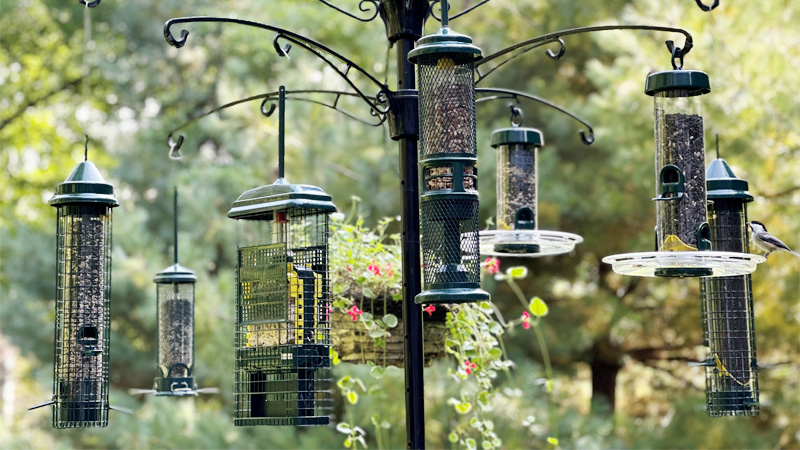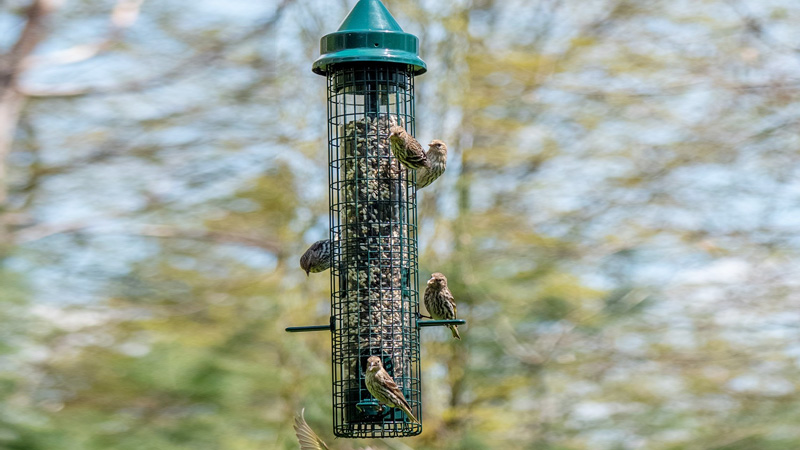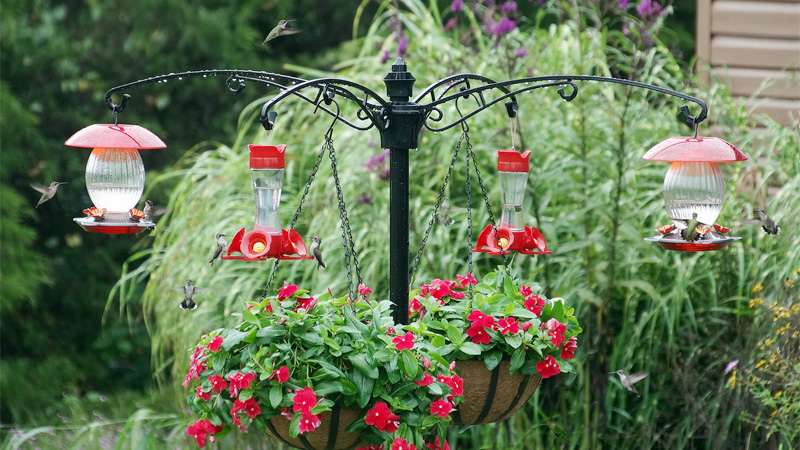Bird feeders have long been a staple in many backyards, attracting a vibrant array of avian visitors. While they provide entertainment and a closer connection to nature for bird enthusiasts, their ecological justification extends far beyond mere enjoyment.
Bird feeders play a vital role in supporting local ecosystems and biodiversity, offering numerous benefits that extend beyond the boundaries of our own gardens.
In this exploration of ‘What is the ecological justification for bird feeders‘, we will delve into the multifaceted reasons why these simple contraptions are more than just a source of entertainment.
From aiding migratory birds during harsh seasons to promoting pollination and pest control, bird feeders serve as valuable tools in the broader conservation effort.
By understanding the ecological significance of bird feeders, we can better appreciate their role in sustaining the delicate balance of our natural world and the vital role they play in ensuring the survival of our feathered friends.

What Is the Ecological Justification for Bird Feeders?
Bird feeders play a significant role in nurturing biodiversity and supporting the overall health of local ecosystems. Here, we’ll shed light on how these seemingly humble installations contribute to the intricate web of life on our planet.
Survival Through Harsh Seasons
One of the most apparent ecological benefits of bird feeders is their role in helping birds survive during challenging times, such as harsh winters or periods of food scarcity.
When natural food sources become scarce, bird feeders provide a reliable and accessible source of nutrition for our feathered friends. This sustenance is critical for their survival, especially when other food sources are limited.
Birds, with their high metabolic rates, require a constant supply of energy-rich foods. In cold weather, they need extra calories to maintain their body temperature.
By providing a consistent supply of seeds, suet, or nectar, bird feeders offer a lifeline to birds when natural foraging is insufficient. This support is particularly crucial for non-migratory birds that stay in colder regions year-round.
Aid for Migratory Birds
Bird feeders can also be a saving grace for migratory birds during their arduous journeys. Many bird species undertake long-distance migrations, and these journeys require enormous amounts of energy.
When migrants pass through urban or suburban areas, bird feeders can provide essential refueling stations.
By offering nourishment to these weary travelers, we help ensure that they have the strength to complete their migrations successfully.
This is not only a matter of survival for individual birds but also contributes to the overall health and stability of avian populations.
Biodiversity Enhancement
Bird feeders have the potential to increase the diversity of bird species in a given area. When you set up different types of feeders with a variety of foods, you attract a wide range of bird species. This diversity contributes to the overall biodiversity of your local ecosystem.
As different bird species visit your feeders, they also play various ecological roles. Some birds are seed eaters, while others are insectivores or nectar feeders. Each of these roles has cascading effects on the ecosystem.
For example, insect-eating birds can help control pest populations in your garden, reducing the need for chemical pesticides.
Seed Dispersal and Plant Regeneration

Birds play a vital role in seed dispersal, and bird feeders can enhance this natural process. When birds visit feeders and consume seeds, they often drop or scatter seeds in various locations.
This unintentional planting helps regenerate native plants and contributes to the restoration of natural habitats.
Moreover, some bird species have specialized diets and prefer particular types of seeds or fruits. By offering a diverse selection of seeds in your feeders, you can attract a wider range of birds with varying preferences, further enhancing seed dispersal and plant diversity in your area.
Pollination Assistance
While birds primarily feed on seeds, some are also nectar feeders. Hummingbirds, for example, rely on nectar from flowers as a primary food source.
By providing nectar feeders filled with sugar water or planting nectar-rich flowers nearby, you can attract these pollinators to your garden.
The presence of hummingbirds and other nectar-feeding birds can enhance pollination in your garden, leading to increased fruit and seed production for various plants. This, in turn, supports the entire ecosystem by providing food and habitat for other wildlife.
Education and Conservation
Bird feeders serve as valuable tools for education and conservation. When people observe birds at their feeders, it fosters a sense of connection with nature and an appreciation for wildlife.
This increased awareness often leads to greater interest in conservation efforts and the protection of natural habitats.
Additionally, many bird feeders are equipped with cameras or webcams that allow enthusiasts to share their observations with a broader audience. This can contribute to citizen science projects and the collection of valuable data on bird behavior, distribution, and population trends.
Mitigating the Impact of Habitat Loss
Habitat loss due to urbanization and land development is a significant threat to bird populations worldwide. Bird feeders can help mitigate the impact of habitat loss by providing supplementary food and shelter in areas where natural habitats have been disrupted or destroyed.
In suburban and urban environments, bird feeders act as oases for birds, offering a safe haven amidst concrete and human activity. This, in turn, allows some bird species to thrive in areas where they might otherwise struggle to survive.
How Do I Make My Bird Feeder Eco-Friendly?

Creating an eco-friendly bird feeder is a wonderful way to attract and support local bird populations while minimizing your environmental impact. By following these tips and incorporating sustainable practices, you can make your bird feeder not only bird-friendly but also environmentally responsible.
Choose Sustainable Materials
Start by selecting bird feeder materials that are environmentally friendly. Opt for feeders made from sustainable materials such as bamboo, recycled plastic, or FSC-certified wood. These materials are renewable and reduce the demand for virgin resources.
Avoid Harmful Chemicals
Ensure that the paints, stains, or finishes used on your bird feeder are non-toxic and safe for wildlife. Harmful chemicals can leach into the environment and harm birds or other animals that come into contact with the feeder.
Use Recycled or Upcycled Materials
Get creative by repurposing materials you already have at home. For instance, you can turn old teacups, bowls, or tin cans into charming bird feeders. This not only reduces waste but also adds a unique touch to your feeder.
Position Your Feeder Wisely
Where you place your feeder can have an impact on its eco-friendliness. Position it near-native plants and trees, as this provides natural shelter and additional food sources for birds. Placing it away from windows can also help prevent bird collisions.
Provide a Water Source
Adding a small birdbath or water dish near your feeder can be a valuable addition. Birds need water not only for drinking but also for bathing and preening. Keep the water clean and refreshed regularly to prevent the spread of diseases.
Offer Organic Bird Food
Choose birdseed and other bird foods that are organic and free from pesticides. Look for products with the USDA organic certification or source your seeds from local, pesticide-free sources.
Organic options support healthier bird populations and promote soil and water conservation.
To minimize waste, use feeders designed to prevent spillage and keep seeds dry. This helps ensure that the bird food you provide is efficiently consumed, reducing the likelihood of attracting unwanted pests.
Employ Sustainable Feeding Practices
Establish a feeding routine that matches the natural feeding patterns of local birds. For example, feed them during the winter when natural food sources may be scarce, and reduce or suspend feeding during the warmer months when birds can find an abundance of insects and seeds in the wild.
Clean Your Feeder Regularly
Regular cleaning of your bird feeder is essential to prevent the spread of diseases among birds. Use eco-friendly, biodegradable cleaning solutions to wash your feeder, and avoid using harsh chemicals that can harm both wildlife and the environment.
Plant Native Plants
Complement your bird feeder with native plants in your garden. Native plants provide natural food sources for birds, such as seeds, berries, and insects. They also support local pollinators and other wildlife, creating a healthier and more biodiverse environment.
Keep an eye on the bird activity around your feeder. If you notice signs of disease or aggressive behavior, consider suspending feeding temporarily to allow birds to disperse and find alternative food sources.
Promote Sustainable Pest Control
Implement eco-friendly pest control methods to keep unwanted visitors, such as squirrels or raccoons, away from your bird feeder. This can include using squirrel-proof feeders or employing natural deterrents like planting mint or marigolds nearby.
Support Conservation Efforts
Consider joining local or national bird conservation organizations. These groups often provide guidance on eco-friendly bird feeding practices and advocate for the protection of bird habitats.
Educate Others
Share your knowledge and passion for eco-friendly bird feeding with friends, family, and neighbors. Encourage them to adopt sustainable practices as well, creating a network of eco-conscious bird enthusiasts.
Practice Patience and Observation
Lastly, be patient and enjoy the opportunity to observe the birds that visit your feeder. Taking the time to watch their behaviors and interactions can deepen your connection with nature and foster a greater appreciation for the importance of bird conservation.
Incorporating these eco-friendly practices into your bird feeding routine can help create a harmonious balance between providing for local bird populations and minimizing your environmental impact.
By doing so, you contribute not only to the well-being of birds but also to the overall health and sustainability of the ecosystem in your backyard.
FAQs
What types of birds can I attract with a recycled bird feeder?
The types of birds you attract to your recycled bird feeder will depend on the location and the type of birdseed you use. Common visitors might include sparrows, chickadees, finches, and cardinals.
How do I prevent squirrels and other pests from raiding the bird feeder?
Squirrels and other pests can be a common challenge. To deter them, you can try using squirrel-proof feeders with mechanisms that prevent larger animals from accessing the seed.
Additionally, placing the feeder at least 10 feet from trees or structures can make it harder for squirrels to reach.
How often should I refill the bird feeder?
The frequency of refilling your bird feeder will depend on the number of birds visiting and the capacity of your feeder. In general, you’ll need to replenish the seed when it gets low or empty.
During colder months when birds require more energy, you may need to refill it more often.
Can I use any plastic bottle for a recycled bird feeder?
While you can use various types of plastic bottles, it’s best to choose one that is clean, free of chemicals and does not have any sharp edges or protrusions that could harm the birds.
Soda or water bottles are commonly used because they are readily available and easy to work with.
Are there any other materials I can use to create a recycled bird feeder?
Absolutely! You can get creative with recycled materials. For instance, you can use old tea cups, mason jars, or even pieces of scrap wood to craft unique bird feeders. The key is to ensure that the materials are safe for both birds and the environment.
Conclusion
Bird feeders are not just decorative garden ornaments; they are ecological lifelines. These humble installations provide food and refuge for a diverse array of bird species, supporting their survival through the harshest seasons.
Moreover, they contribute to broader ecological efforts by promoting biodiversity, aiding in pollination, and controlling pest populations. As we fill our feeders and watch the colorful visitors that grace our yards, we must recognize our role in the larger ecosystem.
Bird feeders are not a substitute for natural habitats, but they serve as crucial supplements, especially in areas where habitat destruction and climate change threaten our avian friends.
So, the next time you refill your feeder, remember that you are not just feeding birds; you are nurturing the ecological balance that sustains life on our planet.
By understanding and appreciating the ecological justification for bird feeders, we can continue to enjoy the beauty of these creatures while actively contributing to the preservation of our natural world.